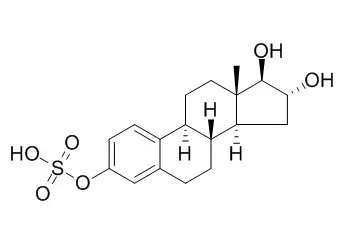| Steroids. 1984 Mar;43(3):235-42. |
| Specific antisera for the radioimmunoassay of estriol 3-sulfate.[Pubmed: 6523541 ] |
METHODS AND RESULTS:
Antisera were raised in male guinea pigs against 6-oxoEstriol 3-sulfate O-carboxymethyloxime-bovine serum albumin (BSA) conjugate. The antisera to this antigen exhibited high affinity (Ka=4.7 X 10(9)M-1) and excellent specificity for Estriol 3-sulfate, showing slight cross-reactions (less than 0.43%) with other estrogen sulfates, and no cross-reactivities with free estrogens and other steroids (less than 0.01%) except cholesterol sulfate (0.22%).
CONCLUSIONS:
A standard curve using [6, 7-3H]-Estriol 3-sulfate as the radioactive ligand showed high sensitivity in the range of 10-1000 pg Estriol 3-sulfate. |
| Steroids. 1998 Oct;63(10):516-22. |
| Bridge-heterologous chemiluminescence enzyme-linked immunosorbent assay of estriol 3-sulfate in pregnancy plasma.[Pubmed: 9800282] |
METHODS AND RESULTS:
A facile and sensitive chemiluminescence enzyme-linked immunosorbent assay (ELISA) of Estriol 3-sulfate using a bridge-heterologous system was established. 6 alpha-HydroxyEstriol 3-sulfate 6-hemisuccinate was synthesized as a novel hapten. Antisera were raised in male guinea-pigs against 6 alpha-hydroxyEstriol 3-sulfate 6-hemisuccinate-bovine serum albumin (BSA) and 6-oxoEstriol 3-sulfate O-carboxymethyloxime-BSA conjugates. Both haptens were coupled to horseradish peroxidase as an enzyme-label reagent. For separation of free and Estriol 3-sulfate bound to the antibody, the crude globulin fractions of these antisera were immobilized to CNBr-activated Sepharose-4B. The enzyme activity was measured by chemiluminescent reaction using amino-butylethylisoluminol and hydrogen peroxide as a substrate. The immobilized antibody raised against 6 alpha-hydroxyEstriol 3-sulfate 6-hemisuccinate-BSA exhibited a high affinity and an excellent specificity for Estriol 3-sulfate. The two bridge-heterologous ELISAs were more sensitive than the homologous systems. The specificity and sensitivity (10 pg) of the bridge-heterologous chemiluminescence ELISAs was comparable to those of the radioimmunoassays (RIAs).
CONCLUSIONS:
Results obtained by the ELISA and the RIA in pregnancy plasmas, showed excellent correlation between ELISA and RIA (r = 0.96). |
| J Clin Endocrinol Metab. 1981 Oct;53(4):847-51. |
| On the occurrence and transport of estriol-3-sulfate in human breast cyst fluid: the metabolic disposition of blood estriol-3-sulfate in normal women.[Pubmed: 7287868] |
METHODS AND RESULTS:
The high concentration of Estriol 3-sulfate (E3-3S) in human breast cyst fluid has been confirmed in 14 women with multiple cysts. The concentrations of Estriol 3-sulfate found in individual cysts drained within a short time span from the same patient were variable, the ratios ranging from unity to 40. After the iv administration of [14C]estriol or [3H]Estriol 3-sulfate, only minor accumulation of either isotope was detected in the cyst fluids aspirated 6.5-30 h later. Since surprisingly small amounts of isotopes were found in blood, the metabolism of [3H]Estriol 3-sulfate was studied in 2 normal women. The test compound was injected iv, and blood samples were taken at intervals up to 7.5 h. In addition, total urine was collected for 3 days. The blood clearance of [3H]Estriol 3-sulfate was rapid, with the half-life ranging from 15-30 min. However, Estriol 3-sulfate was only a minor component of the urine, indicating rapid tissue extraction and metabolism rather than renal excretion for the compound.
CONCLUSIONS:
The studies indicate that Estriol 3-sulfate of human breast cyst fluid does not equilibrate rapidly with other body pools and that its uptake, if any, from the blood would be against a gradient. |






 Cell. 2018 Jan 11;172(1-2):249-261.e12. doi: 10.1016/j.cell.2017.12.019.IF=36.216(2019)
Cell. 2018 Jan 11;172(1-2):249-261.e12. doi: 10.1016/j.cell.2017.12.019.IF=36.216(2019) Cell Metab. 2020 Mar 3;31(3):534-548.e5. doi: 10.1016/j.cmet.2020.01.002.IF=22.415(2019)
Cell Metab. 2020 Mar 3;31(3):534-548.e5. doi: 10.1016/j.cmet.2020.01.002.IF=22.415(2019) Mol Cell. 2017 Nov 16;68(4):673-685.e6. doi: 10.1016/j.molcel.2017.10.022.IF=14.548(2019)
Mol Cell. 2017 Nov 16;68(4):673-685.e6. doi: 10.1016/j.molcel.2017.10.022.IF=14.548(2019)